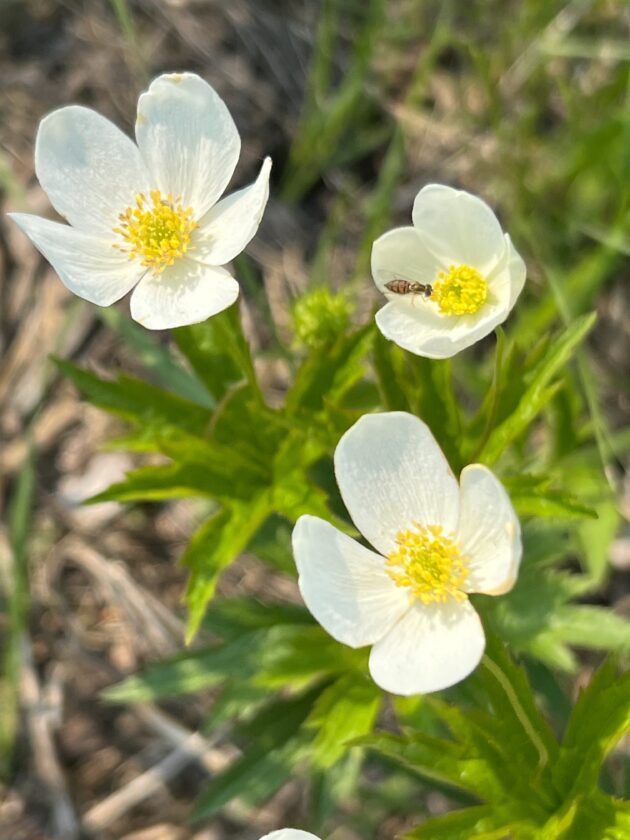Bees, butterflies and blossoms highlight National Pollinator Week

A bee collects pollen from native anemone flowers. Photo by Deb Steinberg
NEW ULM – Pollinators (bees, butterflies and hummingbirds) are some of the unsung heroes of the natural world, silently working to keep our planet blooming and thriving.
Pollinator Friendly New Ulm will be celebrating National Pollinator Week starting June 16th through June 22 with special events hosted in the Pollinator Park at 2250 N. Broadway on Tuesday, June 17 and Saturday, June 21.
At 7 p.m. Tuesday, June 17 and 9 a.m. Saturday, June 21 Master Naturalists and park representatives will be giving guided tours and answering questions. Free native plants will be available on a first come, first serve basis. Donations to the Pollinator Park will be accepted. This is a perfect time to get outdoors and view native wildflowers and pollinating insects in action.
Planting information is also available for any type of garden big or small, located in the “My Little Pollinator Resource Center.” Educational signage is also throughout the garden walking paths to help explain different options to prepare a garden.
What is pollination?

A wild prairie rose with three bees collecting pollen. Photo by Deb Steinberg
Pollination is a process that helps plants make fruits like apples, strawberries and oranges, and also makes seeds for plants to grow new flowers. Pollination is responsible for much of the food on the planet. Pollination is also crucial for making things use every day, like cotton for clothes and wood for furniture. Without pollinators like bees and butterflies, many plants wouldn’t be able to reproduce, and we wouldn’t have enough food or materials to go around. That’s why it’s super important to take care of our pollinators and make sure they have plenty of flowers to visit and places to live.
How does pollination work?
Pollination happens when pollen moves from one flower to another. This transfer can happen with the help of bees, butterflies, birds, and even the wind. As the pollinator moves from flower to flower, tiny grains called pollen stick to its body. When the pollinator lands on another flower of the same kind, some of this pollen rubs off of their body and will fertilize the plant. This transfer of pollen is called pollination. Only pollinated fertilized plants can make fruit and/or seeds.
It’s not just bees and butterflies – many different insects are able to pollinate like flies, moths, wasps and beetles.
How can people help pollinators? By working to create and protect habitats where pollinators can thrive. This includes planting native wildflowers and creating pollinator friendly gardens that provide food and shelter throughout the year. Even a small pot of pollinator plants can help.

A bee climbs through a yellow goatsbeard flower. Photo by Deb Steinberg
Consider planting a variety of native plants in a garden or community spaces to provide food and habitat for pollinators. Avoid using pesticides and herbicides whenever possible.
For more information on pollinators, the public is encourage to attend the Master Naturalists events Tuesday, June 17 and Saturday, June 21.
- A bee collects pollen from native anemone flowers. Photo by Deb Steinberg
- A wild prairie rose with three bees collecting pollen. Photo by Deb Steinberg
- A bee climbs through a yellow goatsbeard flower. Photo by Deb Steinberg
- A single bee collects pollen from a prairie rose. Photo by Deb Steinberg
- A bee climbs inside a native spiderwort to collect pollen. Photo by Deb Steinberg
- A bee buzzes around a native spiderwort flower. Photo by Deb Steinberg
- The Pollinator Park at 2250 N. Broadway in New Ulm will hosts Master Naturalists Tuesday, June 17 and Saturday, June 21 to answer questions about pollinating plants. The event is part of a celebration of National Pollinator Week. Pollinator Park representatives will also be on hand Tuesday and Saturday to give guided tours of the park. Photo by Clay Schuldt

A single bee collects pollen from a prairie rose. Photo by Deb Steinberg

A bee climbs inside a native spiderwort to collect pollen. Photo by Deb Steinberg

A bee buzzes around a native spiderwort flower. Photo by Deb Steinberg

The Pollinator Park at 2250 N. Broadway in New Ulm will hosts Master Naturalists Tuesday, June 17 and Saturday, June 21 to answer questions about pollinating plants. The event is part of a celebration of National Pollinator Week. Pollinator Park representatives will also be on hand Tuesday and Saturday to give guided tours of the park. Photo by Clay Schuldt












